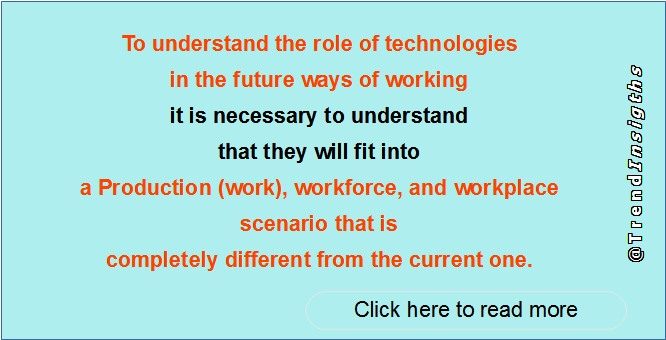
In order to understand how the world of work will look in the future (the production methods, the way people work, etc.) the current technological “inventions” cannot be projected in the same scenario that we see now.
Instead, it is necessary to understand that the Disruptive Innovation in progress today will substantially change the scenario in which in the future the new products (the current new ideas) will be inserted.
<see The need to understand the future scenario to understand the value of disruptive projects >
.
We are moving towards a post-industrial era, in which there will be
► A NEW CONCEPTION OF PRODUCTION.
It is necessary to clarify some fundamental misunderstandings regarding Industry 4.0: the new mode of production (and distribution) will be radically different from the one today defined as Industry 4.0. <see The misunderstanding on Industry 4.0: towards Manufacturing 4.0 >
Today it is necessary:
– a rethinking of the why of a product
– a rethinking of the ideation/design process
– a rethinking of the production/distribution process
< see The Production of the future is not an improvement of the current ones>
.
In the new scenario
we will move from the current mass production
to a Customer driven production.
● That is, we will move from the current industrial production to new modes such as that of “widespread production” developed in a dimension closer to that of the current small industry (in post-industrial mode, decidedly different from the current one).
This new trend, among other things, will generate a new form of Economy, of a local type (able to create more employment); and a production much more flexible than the current one (not requiring the new working methods of highly specialized operators, the Companies can continuously change the type of work to follow the variations in demand).
.
● For example, the concept of automation will change substantially (while we try to improve the automation of the previous generation). <see The need for a new generation of automation (Human Oriented Automation) >
In the near future there will be a sustainable Manufacturing, defined, among other things, by the following features: sustainable automation made of a completely new robotics context (that of Smart Workshop, and Open Factories) – in which, in addition to saving resources and energy, and to a net reduction in pollution, the characteristic of manageability on the part of “non-specialized” personnel (of hobby level ability) will be very important of the production system, of the maintenance of the “machines”, etc …
<sse Towards a radically new model of Industry 4.0: introduction to a Smart Fabrication plan >
.
► A “NEW CULTURE OF WORK”. <see The new dimension of work>
<see The need to update the Peters Principle>
.
► A NEW ROLE OF TECHNOLOGIES
Disruptive Innovation is not based on technology.
It’s not that technologies don’t count. But it no longer makes sense to bring the focus of Design on technologies since them have already developed to point where they allow to evolve pre-industrial production methods (Manufacturing) at a higher level of effectiveness then that of industrial production systems.
< see “The role of technologies in innovation” >
► A RADICALLY NEW PROJECT APPROACH: FOCUS ON HUMAN FACTOR
The focus of Design shifts from technology to the factor that characterizes the new Demand: the Human Factor (Disruptive innovation derives from the need to to recover the human qualities of the Market).
<see Why Hi-Tec and disruptive innovation are incompatible (the “Human factor”) >


